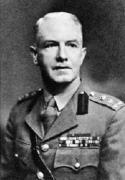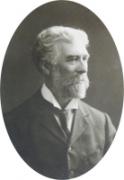|
|
||||||||||||||||||||||||
 |
Featured person
Recently added |
John Alexander Sinton VC FRS (1884 - 1956): |
||||||||||||||||||||||

|
| John Alexander Sinton |
Sinton was a highly distinguished figure in the medical world in two rôles: as an army doctor who saw service in both world wars, and as a medical researcher, especially in malariology on which he became an outstanding international expert. He is particularly notable for being the only person to achieve the United Kingdom's highest military award for bravery, the Victoria Cross, and also to be elected a Fellow of the Royal Society, the United Kingdom organisation whose membership is composed of many of that country's as well as the world's most eminent scientists.
Although born in Vancouver, British Columbia, Sinton was nevertheless an Ulsterman through his parents, Walter Lyon Sinton, from a Quaker linen manufacturing family, and Isabella, of the Pringle family of Derrymore House estate, near Bessbrook, County Armagh (which in 1859 had been bought and developed by John Grubb Richardson, member of the prominent Quaker linen-manufacturing family, whose relatives included his nephew Henry Barcroft, and great-nephew Sir Joseph Barcroft). John Sinton's parents were married in the Bessbrook Friends Meeting House in 1880.
The family moved back to Ulster in 1890, where John attended the Nicholson Memorial School, Lisburn, followed by the Royal Belfast Academical Institution, 1899-1902. While at school in Belfast John lived with his mother at Woodvale, in the west of the city. He then attended Queen's College, Belfast (the direct forerunner of Queen's University, Belfast but then still a recognised College of the Royal University of Ireland) and graduated MB, BCh, BAO with first class honours in Medicine, second class honours (first place) with exhibition in Surgery and first class honours with exhibition in Midwifery and Gynaecology. He took various medical posts in Belfast and also obtained the Diploma in Public Health, Belfast in 1910 and later the same year, the Diploma in Public Health of Cambridge, followed by the Diploma in Tropical Medicine (Liverpool) in 1911. He was first in the entrance examination for the Indian Medical Service and was gazetted lieutenant in the military branch of that Service on 29 July 1911. This was a period of a lot of research and progress by British and Indian Army doctors in the area of tropical medicine and pathology, especially concerning the investigation and treatment of protozoal infections.
On arrival in India, Sinton was appointed Regimental Medical Officer to the 31st Duke of Connaught's Own Lancers, based at Kohat in North West Frontier Province, and was also in charge of the Brigade Laboratory. In the period before the First World War he published a number of papers on cholera treatment, eosinophilia (a kind of white blood cell disorder) in helminth (parasitic worm) infections, and the culture of malaria parasites.
In October 1915 he was posted as Regimental Medical Officer to the 37th Dogra Regiment which took part in the unsuccessful Mesopotamian campaign in southern Iraq, in very inhospitable territory (described by contemporary soldiers as "two ruddy long rivers [the Tigris and Euphrates] surrounded by miles of Sweet Fanny Adams"), with extremes of temperature and other conditions which could lead to greater casualties from disease than from battle. During fierce fighting in January 1916, the battle of Shaikh Saad, the 37th Dogra Regiment lost one British officer killed, three British and four Indian officers wounded, including Sinton, and 240 casualties in other ranks including 32 killed. Early on in the battle, Sinton suffered several gunshot wounds, but continued his medical duties despite this, ensuring that all the wounded were brought in and treated, even venturing out before dark. For this he was awarded the Victoria Cross, gazetted on 20 June 1916. The citation read: "For most conspicuous bravery and devotion to duty. Although shot through both arms and through the side, he refused to go to hospital, and remained as long as daylight lasted, attending to his duties under very heavy fire. In three previous actions Captain Sinton displayed the utmost bravery." He also was successful in controlling an outbreak of cholera, with a rigorous regimen of inoculations and other precautions. Mentioned in despatches four times, he was awarded the Russian Order of St George.
After a period of invalid leave, he returned to service commanding Cavalry Field Ambulances. From August 1918 until April 1919 he was Senior Medical Officer, Turkistan Military Mission, with the rank of Lieutenant-Colonel. The same year Queen's University awarded him the honorary degree of MD for his academic distinctions and in recognition of his war service record.
In 1921-1936 he was attached to the Pasteur Institute of India based at Kasauli, a hill station near Simla, north-west India. He was soon transferred from there to become Director of the Malaria Survey of India, also based at Kasauli. During his time there he published (some as co-author) over 200 scientific papers on malariology, chemotherapy (he replaced, after large-scale trials, the unpleasant quinine treatment with a new drug, Plasmoquine), parasitology, immunology, laboratory and survey techniques and especially, 36 papers on Indian species of Phlebotomus (a genus of sandfly which carries leishmaniasis or kala-azar) on which he was the leading authority. He retired in 1936, having established for himself a reputation of international standing. His sandfly interest, which may have arisen from constant personal exposure to them in the Mesopotamian Campaign, yielded descriptions of twenty-seven Phlebotomus species, sixteen of which were new to science; he named one Phlebotomus eadithai after his wife (Edith Seymour Steuart Martin, whom he met and married at Kasauli in 1923) and another Phlebotomus eleanorae after his daughter (his only child, born December 1924). Others honoured Sinton by naming three mosquito species, Aedes sintoni, Anopheles sintoni, and Anopheles sintonoides, one sandfly species, Sergentomyia sintoni, and one subgenus Sintonius of the genus Phlebotomus, after him.
During the Second World War Sinton was appointed malariologist to the East Africa Force in 1940, in 1941 being transferred to the Middle East Command in the same rôle. He briefly retired again with the rank of Honorary Brigadier in 1943 but only for two weeks; he was re-employed by the War Office as a consultant malariologist to advise on malaria treatment in Assam, Burma, India, Ceylon, Australia, New Guinea, the Moluccas and the Solomon Islands.
Sinton retired yet again at the end of the War, and redirected his life. First, he settled in Northern Ireland, buying a house near Cookstown, County Tyrone. Further, instead of continuing his scientific work, he busied himself with more civic and public affairs, particularly at Queen's University. He was appointed to the Senate in 1948, Pro-Chancellor in 1952, President of the Queen's University Association in 1953 and President of the Queen's University Services Club. He held senior office in the Belfast Old Instonians Association (the organisation of former pupils of his old school, the Royal Belfast Academical Institution), was a Justice of the Peace, High Sheriff for County Tyrone in 1953 and Deputy Lieutenant in 1954. Queen's University named a Hall of Residence in their Queen's Elms student complex after him.
His long list of honours and distinctions is headed by his election as Fellow of the Royal Society in 1946, which was largely for his outstanding work on malaria and leishmaniasis. In 1946 he was Robert Campbell Orator and Medallist of the Ulster Medical Society. Queen's University awarded him a DSc in 1927, and he was awarded the Chalmers Memorial Medal of the Royal Society of Tropical Medicine and Hygiene 1929, and their highest award, the Manson Medal, just days before his death - it was presented to his widow later in the year. The Egyptian Government awarded his their Anti-Gambia Memorial Medal in 1950 for his services in a malaria epidemic in 1950. He was made an Honorary Member of the National Malaria Society of the United States in 1930, from 1937 until 1946 he was a member of the Malaria Commission of the League of Nations and from 1943 until 1946 a member of the Malaria Commission of the Medical Research Council.
Sinton was a singularly energetic and industrious individual, personally rather intimidating yet popular socially, essentially selfless as well as courageous, not least when digging with his bare hands in the rubble of a collapsed house to rescue three young children buried in it, or tackling a highly venomous Indian krait snake which dropped out of a hanging basket onto a guest. In his retirement years in Northern Ireland he enjoyed fishing, gardening and bird-watching.
He was related to Ernest Thomas Sinton Walton, the only person from Ireland to have won a scientific Nobel Prize (in Physics, 1951), which he was awarded for his work on splitting the atom in 1932.
John Alexander Sinton died at his home near Cookstown and was buried with full military honours at Claggan Presbyterian cemetery in Cookstown.
| Born: | 2 December 1884 |
| Died: | 25 March 1956 |
| Richard Froggatt |
| Acknowledgements: Wesley McCann |
| Bibliography: Oxford Dictionary of National Biography; London Gazette, 21 June 1916; Felix Lavery, Irish Heroes in the War (1917), 285-6; The Times, 27.3.1956, 13; Tyrone Constitution, 30 Mar. 1956; Nora Buzzell (ed.), The Register of the Victoria Cross (1981), 241; Farset Youth Project, Ireland's VCs (1996), 89; John F. Riddick, Who Was Who in British India (1998), 332; Richard Doherty and David Truesdale, Irish Winners of the Victoria Cross (2000), 131-2, 231; Biographical Memoirs of Fellows of the Royal Society; Peter Froggatt, Ulster Medical Journal, vol. 56 (Supplement), pp. S36 - S40 |


Home | Our Policies | Plaques | Browse | Search | Sponsors | Links | Help | Contact
Privacy & Disclaimer | Cookie Policy | Site Map | Website Design By K-Point
© 2024 Ulster History Circle









